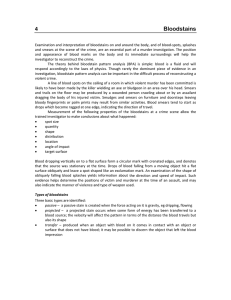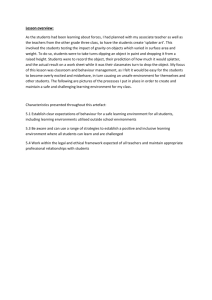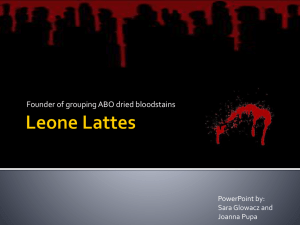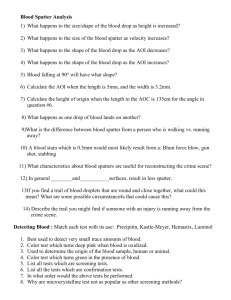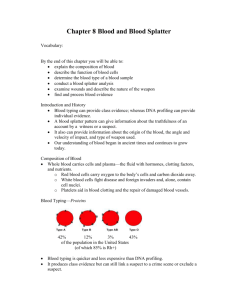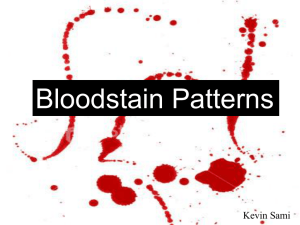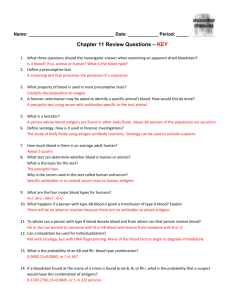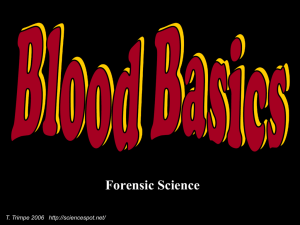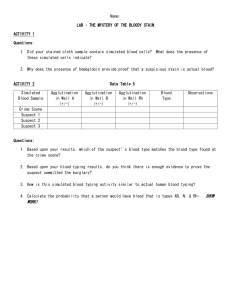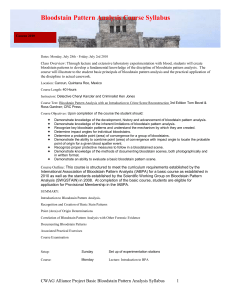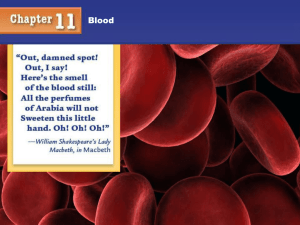Identification Of blood, typing, And Splatter
advertisement
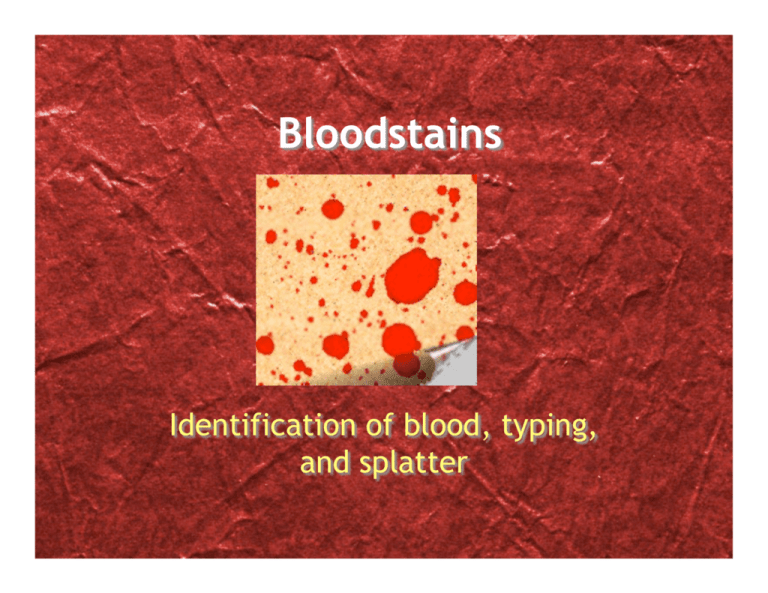
Bloodstains Identification of blood, typing, and splatter 3 questions about an unknown stain 1. Is it blood? 2. From what species did the blood originate? 3. If the blood is of human origin, how closely can it be associated to a particular individual? Is it Blood? Preliminary Color Tests 1. Benzidine Color Test - Benzidine is carcinogen so not used as often Benzidine + Blood Stain + Hydrogen peroxide = pink color 2. Kastle-Meyer Color Test -phenolphthalein Phenolphthalein + Bloodstain + Hydrogen peroxide = pink color Is it Blood? (con.) 3. Luminol Test - Reacts with blood to produce luminescence • • Sensitive to blood that have been diluted up to 10,000 times Destroys many important blood factors 5. Microcrystalline Tests - hemoglobin will form characteristic crystals • less sensitive and more susceptible to interference from contaminants Luminol Test Kastle-Meyer Test Human or Animal origin? Precipitin Test • Combine human antiserum and human bloodstain there should be agglutination • Requires only small amount of blood • Dried bloodstains as old as 10 - 15 years work Gel Diffusion • Human antibodies and bloodstain are placed in wells on an agar gel. If antibodies and antigens move towards each other and form a line of precipitation, it is human blood. Electrophoretic Method • Similar to Gel diffusion except electrical current is used to move antibodies and antigens towards each other Matching blood to a person 1. Blood type 2. Blood Cell surface enzymes 3. DNA Analysis Blood Type basics • Four blood types - A (39%), B (11%), AB (4%) and O (46%) • Rh Factor -83% of population are positive • Testing for blood type is done through agglutination and antibodies • 80% of the human population are secretors Typing blood 1. Separately add A and B antibodies to a few drops of the blood sample. 2. Look for agglutination. 3. Agglutination will occur only if the antigens are present on the RBC. 4. No agglutination with either = O. 5. Agglutination with both = AB Typing of dried bloodstains RBC rupture when they dry so agglutination tests are not possible on dried blood stains Absorption-Elution Technique - Four steps to typing dried bloodstains Step 1 - Place antiserum on bloodstain. Step 2 - Wash off unreacted serum Step 3 - Heat stained material to cause elution (breaking) of antibody-antigen bond Step 4 - Combine antibodies from bloodstain with known RBCs. If agglutination occurs then the bloodstain can be typed Blood Enzymes and Proteins • Blood cells contain several different enzymes in them that can be identified. The best enzymes to identify for forensic purposes are those that are polymorphic or have iso-enzymes • The more factors that are identified in a bloodstain, the smaller its frequency of occurrence. • Example: PGM (phosphoglucomutase) is found in 10 different forms that can be isolated by electrophoresis. Preservation of Blood Evidence • Photograph all blood close up and relative to the entire crime scene. • Collection of all body fluids must be handled with disposable gloves. • All clothing with blood on them should be individually bagged and sent to the lab. • Bloodstains on substances that can not be removed should be scraped off. A portion of the surface near the stain should also be removed. Bloodstains can also be removed using a swab moistened with distilled water Blood Splatter Rules 1. Surface texture effects bloodstain patterns. • Harder and less porous the surface the less splatter. 2. Direction of Blood’s travel may be shown by the stains shape • Pointed end of a bloodstain always faces the direction it traveled. 3. It is possible to determine the impact angle of blood on a flat surface by measuring the degree of circular distort. • Larger angles beyond 90 degrees the more elongated the stain. 4. The origin of a Blood splatter can be established by drawing straight lines through the long axis of several individual bloodstains. • The point of convergence of the lines represents the point from which the blood originated. Different types of splatter Angle of Impact Blood at the scene 90 ˚ angle Lack of splatter The lack of splatter can also indicate what might have happened at a crime scene. A person holding a weapon, should not have splatter where the weapon was.

